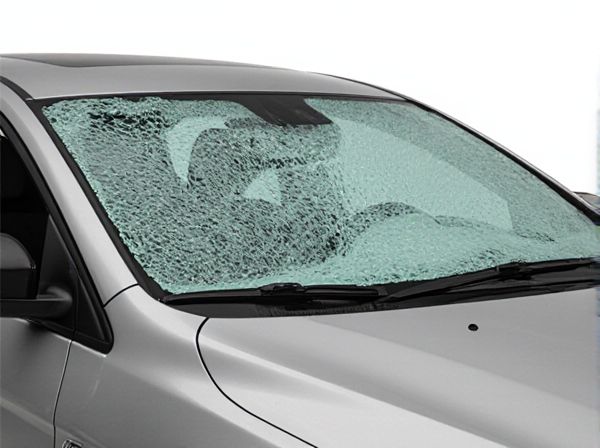
Photo illustration: Infrared-Absorbing vs Regular
Infrared-absorbing materials are specifically designed to block or absorb infrared radiation, reducing heat transfer and increasing energy efficiency. Regular materials typically allow infrared rays to pass through, resulting in higher heat absorption and less thermal protection. Choosing infrared-absorbing options can help you maintain cooler indoor temperatures and lower energy costs.
Table of Comparison
| Feature | Infrared-Absorbing Windshield | Regular Windshield |
|---|---|---|
| Heat Reduction | Minimizes infrared heat penetration, keeping cabin cooler | No infrared heat blocking, allows more heat inside |
| UV Protection | Blocks up to 99% of UV rays | Standard UV protection, less effective |
| Glare Reduction | Reduces glare from sun and headlights | Minimal glare reduction |
| Energy Efficiency | Improves air conditioning efficiency | No impact on energy consumption |
| Cost | Higher initial investment | Lower upfront cost |
| Durability | Comparable lifespan to regular windshields | Standard durability |
Introduction to Infrared-Absorbing vs Regular Materials
Infrared-absorbing materials selectively absorb infrared radiation, preventing heat transfer and improving thermal management in applications such as coatings, windows, and textiles. Regular materials typically allow infrared radiation to pass through or reflect it without significant absorption, resulting in less effective thermal insulation. Understanding the differences in infrared absorption properties is crucial for optimizing energy efficiency and comfort in residential, automotive, and industrial environments.
What Are Infrared-Absorbing Materials?
Infrared-absorbing materials are specialized substances designed to selectively absorb infrared radiation, preventing heat transmission and enhancing thermal insulation in various applications such as coatings, textiles, and optical filters. Unlike regular materials that may reflect or transmit infrared rays, these materials convert infrared energy into other forms, often heat, which can then be dissipated or managed effectively. Their ability to control infrared radiation improves energy efficiency in buildings, electronic devices, and solar control technologies.
How Regular Materials Interact with Infrared Waves
Regular materials primarily absorb or reflect infrared waves depending on their molecular structure and surface properties, with many common substances allowing significant infrared transmission or reflection rather than absorption. These materials convert a portion of the absorbed infrared radiation into heat, increasing their temperature, which affects thermal comfort and energy efficiency in applications like building insulation and textiles. Infrared-absorbing materials, in contrast, are engineered to maximize absorption and minimize reflection, providing enhanced thermal management by effectively trapping infrared energy.
Key Differences in Absorption Mechanisms
Infrared-absorbing materials utilize molecular vibrations and electronic transitions specifically tuned to capture infrared radiation, effectively converting it into heat or other energy forms, whereas regular materials primarily reflect or transmit IR radiation without significant absorption. The absorption mechanism in infrared-absorbing substances often involves specific chemical bonds or nanostructures designed to target IR wavelengths, contrasting with the more general electronic bandgap interactions seen in regular materials. These key differences influence thermal management applications, sensors, and energy harvesting technologies by dictating how each material interacts with infrared light.
Energy Efficiency: Infrared-Absorbing vs Regular
Infrared-absorbing materials significantly enhance energy efficiency by reducing heat transfer through windows, lowering cooling costs during hot weather. Regular glass allows more infrared radiation to penetrate, increasing indoor temperatures and reliance on air conditioning. By blocking or absorbing infrared rays, infrared-absorbing coatings improve thermal insulation and contribute to sustainable building design.
Applications in Construction and Architecture
Infrared-absorbing materials are crucial in construction and architecture for enhancing energy efficiency by reducing heat transmission through windows and building facades, thereby lowering cooling costs. Regular materials, lacking infrared absorption properties, often lead to higher indoor temperatures and increased reliance on air conditioning systems. Implementing infrared-absorbing coatings and films in architectural designs helps maintain thermal comfort and contribute to sustainable building practices.
Impact on Thermal Regulation and Comfort
Infrared-absorbing materials excel in thermal regulation by reducing heat transfer, thereby maintaining cooler indoor temperatures and enhancing comfort in hot climates. Regular materials lack this specific property, often causing increased heat absorption and discomfort due to higher indoor temperatures. Utilizing infrared-absorbing coatings or fabrics significantly improves energy efficiency and occupant comfort by minimizing solar heat gain.
Cost Considerations and Material Availability
Infrared-absorbing materials typically incur higher costs due to specialized manufacturing processes and limited raw material sources, whereas regular materials benefit from widespread availability and lower production expenses. The cost difference is influenced by the complexity of incorporating infrared-absorbing compounds, which are often sourced from rare or engineered substances, impacting scalability. Evaluating project budgets requires balancing the premium pricing of infrared-absorbing materials against potential energy savings and performance benefits over conventional alternatives.
Environmental Implications of Material Choices
Infrared-absorbing materials reduce heat transfer by capturing infrared radiation, leading to lower energy consumption for cooling and decreased greenhouse gas emissions. Regular materials often reflect or transmit infrared radiation, resulting in higher indoor temperatures and increased reliance on air conditioning systems. Choosing infrared-absorbing coatings or films contributes to sustainable building practices by enhancing energy efficiency and minimizing environmental impact.
Selecting the Right Material for Your Needs
Infrared-absorbing materials are engineered to selectively block or absorb infrared radiation, making them ideal for applications requiring heat management or enhanced thermal insulation. Regular materials typically lack this specific capability and may allow infrared radiation to pass through, reducing energy efficiency in contexts such as window coatings or protective films. Choosing the right material depends on the intended use, with infrared-absorbing films providing superior performance in energy savings, UV protection, and comfort for automotive, architectural, and electronic device applications.
 caratoz.com
caratoz.com